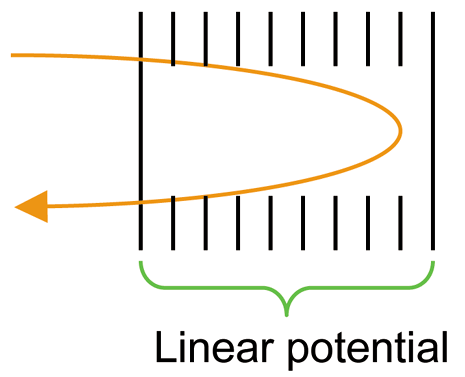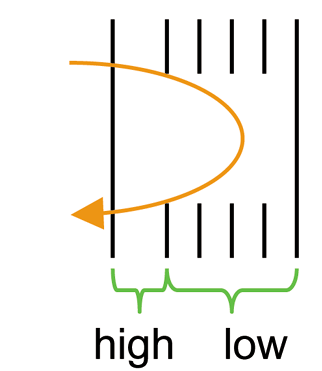
Reflectron
Encyclopedia

Electric field
In physics, an electric field surrounds electrically charged particles and time-varying magnetic fields. The electric field depicts the force exerted on other electrically charged objects by the electrically charged particle the field is surrounding...
in the ion mirror to reverse the direction of travel of the ion
Ion
An ion is an atom or molecule in which the total number of electrons is not equal to the total number of protons, giving it a net positive or negative electrical charge. The name was given by physicist Michael Faraday for the substances that allow a current to pass between electrodes in a...
s entering it. Using the reflectron, one can substantially diminish a spread of flight times of the ions with the same mass-to-charge ratio
Mass-to-charge ratio
The mass-to-charge ratio ratio is a physical quantity that is widely used in the electrodynamics of charged particles, e.g. in electron optics and ion optics. It appears in the scientific fields of lithography, electron microscopy, cathode ray tubes, accelerator physics, nuclear physics, Auger...
(m/z) caused by spread in kinetic energy of these ions measured at the exit from the ion source. The idea of improving mass resolution in TOF MS by implementing the reflection of ions from a region with retarding electric field (the ion mirror) has been first proposed by Russian scientist S. G. Alikhanov . In 1973, the dual-stage reflectron utilizing an ion mirror with two regions of homogeneous field was built in a laboratory of Boris Aleksandrovich Mamyrin
Boris Aleksandrovich Mamyrin
Boris Aleksandrovich Mamyrin was a Russian scientist best known for his invention of the electrostatic ion mirror mass spectrometer known as the reflectron.-Biography:...
.
Mass resolution of the reflectron measured over broad mass range is much larger than that in a simpler (so-called linear) time-of-flight mass spectrometer comprising a pulsed ion source, flight tube, and ion detector. The masses of ions analyzed in the reflectron can span from a few Dalton to a few million Dalton. Sensitivity in the reflectron used for the analysis of ions produced in vacuum by photo or electron ionization, e.g., matrix-assisted laser desorption/ionization
Matrix-assisted laser desorption/ionization
Matrix-assisted laser desorption/ionization is a soft ionization technique used in mass spectrometry, allowing the analysis of biomolecules and large organic molecules , which tend to be fragile and fragment when ionized by more conventional ionization methods...
source, can be lower than in linear TOF MS due to post-source decay - a dissociation of vibrationally-excited molecular ions (often referred as metastable ions).
Single-Stage Reflectron

Linear
In mathematics, a linear map or function f is a function which satisfies the following two properties:* Additivity : f = f + f...
or non-linear. Also, the electric field in the mirror can be constant or time-dependent. In single-stage reflectrons with homogeneous field, a zero field in a field-free region of a flight tube and the homogeneous field inside the ion mirror are separated by highly transparent (~95%) metal grid. The grid position is then referred as the entrance (exit) to the ion mirror and is used to calculate the retarding electric field. The single-stage reflector utilizing homogeneous field can be used to attain high mass resolution in cases where the variation of energies of ions leaving the ion source is small (typically less than a few per cent).
Time of flight t of the ions with mass m, charge q, kinetic energy U is

where L is the path length of the ions in a field-free space, Lm is the length of ion mirror, Um is the voltage applied across the mirror.
To find a first-order compensation condition for flight time t with respect to spread dU in ion energy U, the following condition should be fulfilled

Assume that the kinetic energy of the ions in the field-free region equals the ion potential energy near the stop point of the ions inside the mirror (we assume that this stop point is very close to the back electrode of the mirror, i.e. Um = U).
From here it follows that

In practice, the mirror length should be 10-20% longer to accommodate all ions whose kinetic energy is spread over some interval.
So, the electric field Em in the mirror of a single-stage reflector should be

In case of a wider variation of dU , the relative width of the time-of-flight peaks dt/t in such a reflectron is determined by the uncompensated part of the flight time t(U) proportional to the second derivative
 .
.where k is a constant depending on the parameters of the singe-stage reflector.
Dual-Stage Reflectron

The effect of ion scattering on mass resolution in single- and dual-stage reflectrons can be diminished by utilizing polarized grid geometry .
Gridless Reflectron
One design of gridless reflectron utilizes a "curved-field" ion mirror where the electric potential V(x) along the mirror axis depends non-linearly on distance x to the mirror entrance. Time of flight compensation for ions with different kinetic energy can be obtained by adjusting voltage on the elements producing the electric field inside the mirror, which values follow the equation of an arc of a circleCircle
A circle is a simple shape of Euclidean geometry consisting of those points in a plane that are a given distance from a given point, the centre. The distance between any of the points and the centre is called the radius....
: R2 = V(x)2 + kx2, where k and R are some constants .
The electric potential in the mirror of a "quadratic-field" reflectron is proportional to a square of a distance x to the mirror entrance: V(x)= kx2 thus exhibiting a case of one-dimensional harmonic field. If both the ion source and the detector are placed at the mirror entrance and if the ions travel in a close proximity of the ion mirror axis, the flight time of ions in this "quadratic-field" reflectron are almost independent on ion kinetic energy.
A gridless reflectron with nonlinear field, which design comprising only three elements was also demonstrated .
Bergmann et al implemented numerical approach to finding voltage distribution across the stack of the metal electrodes as in Fig. 1. that allowed one to create a nonlinear field in different regions of the mirror to provide conditions for efficient compensation of flight times caused by the spread of ion kinetic energies for different entry angles of the ion beam.
Post-Source Decay
A post-source decay (PSD) is a process specific to the ion source utilizing matrix-assisted laser desorption/ionizationMatrix-assisted laser desorption/ionization
Matrix-assisted laser desorption/ionization is a soft ionization technique used in mass spectrometry, allowing the analysis of biomolecules and large organic molecules , which tend to be fragile and fragment when ionized by more conventional ionization methods...
and operating in vacuum. In the post-source decay, parent ions (typically of several keV kinetic energy) fragment in a process of laser-induced fragmentation or high-energy collision-induced dissociation (HE CID). Time interval suitable for observation of the post-source decay in the reflectron starts after the precursors (parent ions) leave the ion source and ends prior to the moment when the precursors enter the ion mirror . The kinetic energy of fragment ions of mass m in the post-source decay significantly differs from that of parent ions of mass M and is proportional to m/M. So, the distribution of kinetic energies for the PSD ions is extremely large. Not surprisingly, it cannot be compensated in "classic" single or double-stage reflectrons. To achieve acceptable mass resolution for PSD ions which masses typically distributed over broad mass range, these ions are accelerated to energies substantially (at least, a factor of 4 ) exceeding the initial energy of precursor ions. Use of gridless curved-field mirror or that with time-dependent field also improves the mass resolution for fragment ions generated in the post-source decay.

